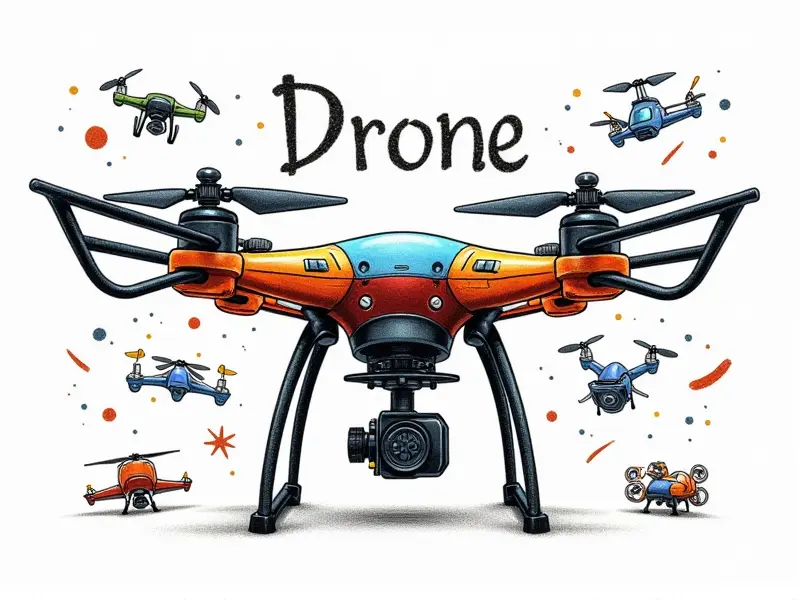What is a VTX in an FPV setup?

Why VTX is Crucial for FPV Pilots
In the world of First-Person View (FPV) drone racing and aerial photography, the Video Transmitter (VTX) plays a pivotal role. A VTX is an essential component that enables pilots to transmit real-time video footage from their drones directly to goggles or receivers on the ground. This allows for immersive flight experiences where pilots can see exactly what their drones are seeing.
Understanding VTX in FPV Systems
The primary function of a VTX is to convert the digital video signal captured by the drone's camera into an analog RF (radio frequency) signal, which is then transmitted wirelessly. This process ensures that pilots can monitor their drones' movements and surroundings with minimal latency.
Key Components
- Video Camera: Captures high-quality video footage from the drone's perspective.
- VTX Module: Converts digital signals to RF for transmission.
- Antenna: Sends and receives radio frequency signals.
Exploring VTX Options for FPV Setup
Choosing the right VTX is crucial for achieving optimal performance in your FPV setup. There are several types of VTXs available, each with unique features tailored to different needs:
Types of VTX Modules
- Fixed Power VTX: Offers a single power output level.
- Variable Power VTX: Allows pilots to adjust the transmission power for better range and clarity.
- Tunable VTX: Provides fine-tuning capabilities across multiple channels.
Maximizing Your FPV Experience with VTX
To get the most out of your VTX, it's important to understand how to configure and optimize its settings. Proper setup can significantly enhance video quality and range:
Optimal Configuration Tips
- Channel Selection: Choose a channel with minimal interference.
- Power Settings: Adjust power output based on your flying environment.
- Antenna Placement: Ensure optimal placement for maximum range and clarity.
VTX 101: Basics for New FPV Enthusiasts
If you're new to the world of FPV, understanding VTX basics is crucial. Here are some fundamental concepts every beginner should know:
Fundamental Concepts
- Frequency Bands: Commonly used bands include 5.8GHz and 1.2GHz.
- Transmission Range: Varies based on power output, antenna quality, and environmental factors.
- Latency: The delay between the drone's camera feed and what you see in your goggles.
The Role of VTX in FPV Racing
In competitive FPV racing, every second counts. A high-quality VTX can provide a significant edge by offering clear, lag-free video transmission:
Performance Enhancements
- Faster Response Time: Enables quicker decision-making during races.
- Better Visibility: Ensures pilots have a clear view of the race track and obstacles.
- Reduced Interference: Minimizes signal disruptions for smoother performance.
Essential Guide to VTX for FPV
This guide provides an in-depth look at everything you need to know about VTXs, from selection criteria to installation and troubleshooting tips:
Selecting the Right VTX
- Budget Considerations: Determine your budget before making a purchase.
- Purpose of Use: Choose based on whether you're racing, filming, or just flying for fun.
- Compatibility: Ensure the VTX is compatible with your drone and goggles.
Installation Tips
- Cable Management: Properly manage cables to avoid interference with other components.
- Secure Mounting: Use appropriate mounting solutions for stability.
- Testing: Conduct thorough tests before flying in competitive or crowded environments.
How VTX Works in FPV Drones
The process of video transmission from an FPV drone to the pilot's goggles involves several steps, each crucial for delivering a seamless experience:
Transmission Process
- Digital Signal Capture: The camera captures digital video footage.
- Analog Conversion: The VTX converts the digital signal to an analog RF signal.
- Signal Transmission: The antenna sends the RF signal to a receiver on the ground.
Choosing the Right VTX for Your FPV Drone
Selecting the appropriate VTX is critical for achieving your desired performance level. Consider factors such as power output, frequency band, and compatibility:
Key Factors to Consider
- Power Output: Higher power means greater range but also increased battery drain.
- Frequency Band: 5.8GHz offers better clarity while 1.2GHz provides longer range.
- Compatibility: Ensure the VTX works with your drone's camera and receiver system.
Maximizing Performance with VTX Settings
To get the best performance from your VTX, it’s essential to fine-tune its settings. Here are some tips for optimizing your setup:
Tuning Tips
- Channel Selection: Choose a channel with minimal interference.
- Power Output Adjustment: Balance power output based on range and clarity needs.
- Antenna Placement: Optimize antenna placement for maximum signal strength.
Exploring the Functionality of VTX
The functionality of a VTX extends beyond basic video transmission. Advanced features such as telemetry and adjustable settings can further enhance your FPV experience:
Advanced Features
- Tuning Capabilities: Fine-tune power output for specific environments.
- Built-in Telemetry: Monitor drone status in real-time via the video feed.
- Multiband Support: Utilize multiple frequency bands for flexibility and reliability.
Conclusion
A high-quality VTX is a vital component of any FPV setup, whether you're racing, filming, or just enjoying recreational flying. By understanding the basics and optimizing your settings, you can ensure clear, lag-free video transmission for an unparalleled flying experience.

